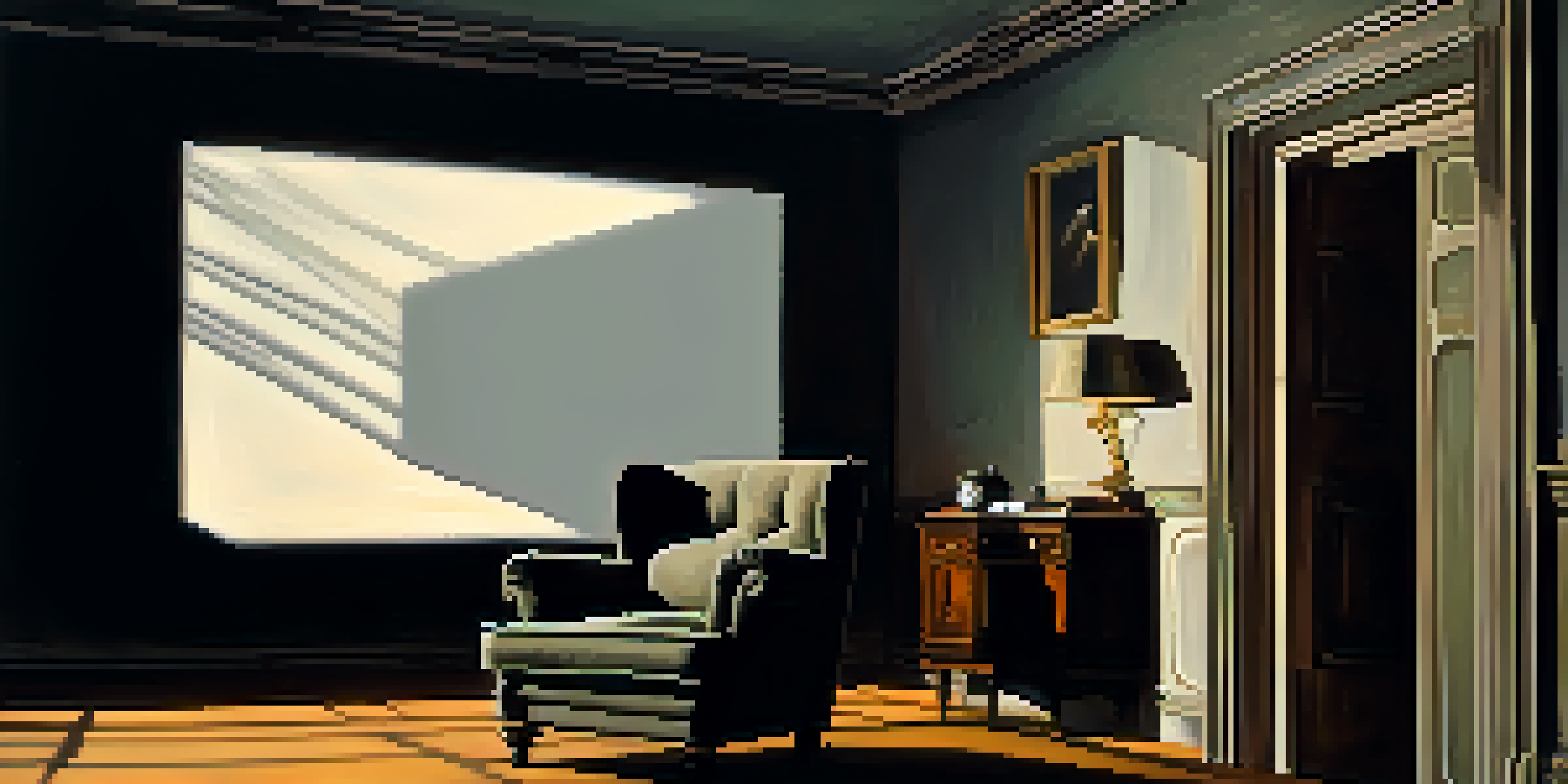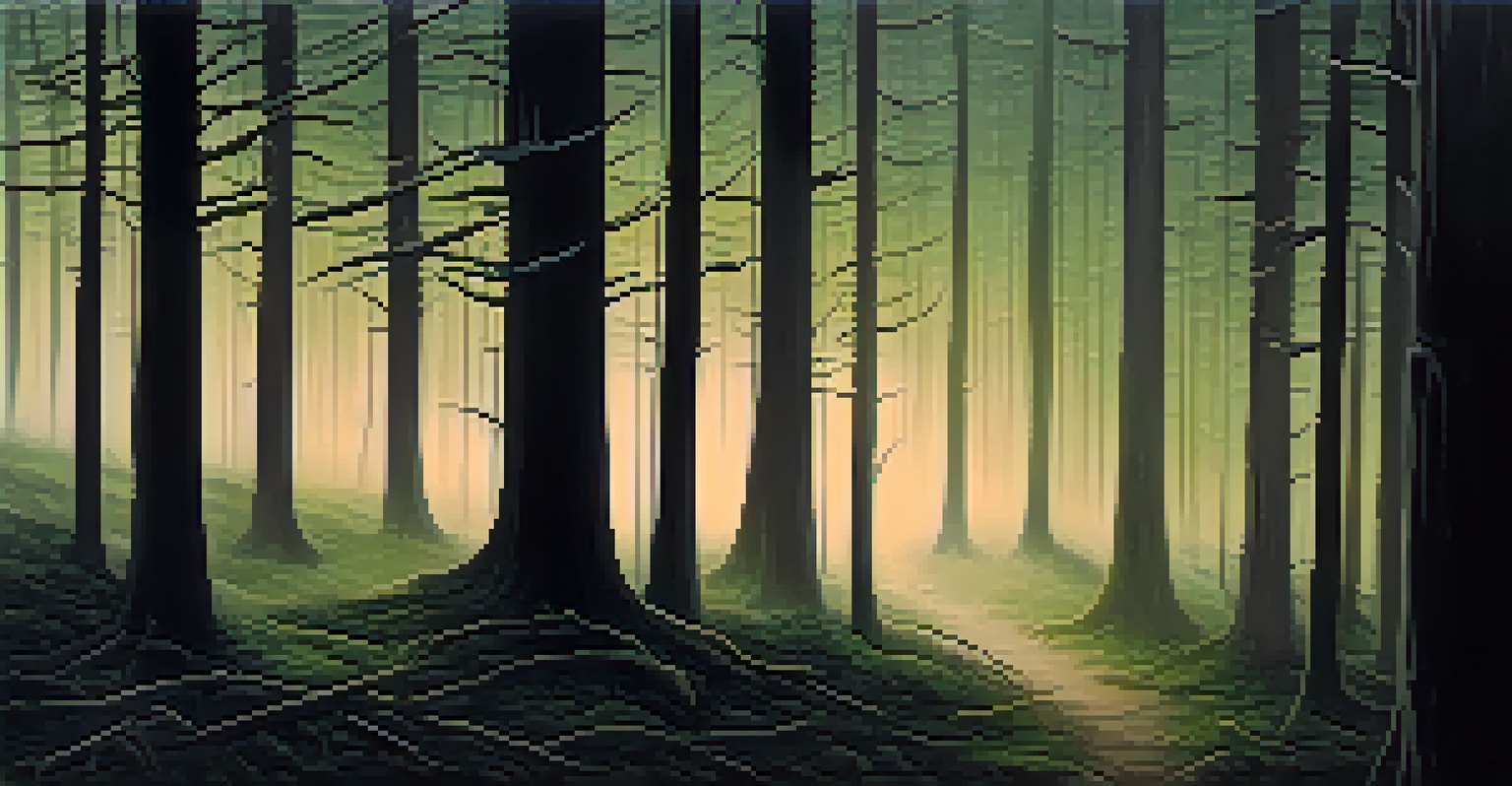Fear and Thrill: The Psychology Behind Horror Films

The Allure of Fear: Why We Love Horror Films
Horror films have a unique way of captivating audiences, tapping into our primal instincts. There's a thrill in experiencing fear in a controlled environment, allowing us to explore our darker emotions safely. The adrenaline rush we feel during a scary scene can be addictive, much like a rollercoaster ride, where the fear is balanced with safety.
Fear is the mind-killer. Fear is the little-death that brings total obliteration.
This paradox of enjoyment often leaves viewers questioning why they choose to subject themselves to unsettling experiences. Many people find comfort in horror, as it can serve as a cathartic release, helping them process real-life fears and anxieties. It's fascinating how a film can evoke such intense emotions that we often struggle to express in our daily lives.
Ultimately, the allure of fear lies in its ability to create a shared experience among viewers, sparking conversations and connections long after the credits roll. By confronting fears through fiction, we can better understand ourselves and the world around us.
The Science of Fear: How Our Brain Reacts
When we watch horror films, our brains undergo a fascinating transformation. The amygdala, the part of our brain responsible for processing fear, becomes highly active, triggering our fight-or-flight response. This biological reaction is why we might feel our heart race or our palms sweat during tense moments in a movie.

Interestingly, this heightened state of awareness can also lead to increased pleasure. Neurotransmitters like dopamine are released, creating a sense of euphoria alongside fear. This chemical cocktail explains why some people seek out horror films repeatedly, as they can elicit both terror and joy.
Horror Films Offer Safe Fear
Horror films allow viewers to experience fear in a controlled environment, providing a thrilling yet safe way to explore darker emotions.
Understanding the science behind our reactions helps demystify why we enjoy being scared. It reveals the complexity of our emotional responses and showcases how our minds can play tricks on us, turning fear into an exhilarating experience.
Cultural Reflections: Horror Films and Society
Horror films often serve as a mirror reflecting societal fears and anxieties. From classic monsters like vampires and zombies to contemporary themes of technology and isolation, these films encapsulate our collective concerns. For example, the rise of horror in the age of social media highlights fears about privacy and the loss of genuine human connection.
There is no terror in the bang, only in the anticipation of it.
Moreover, horror can challenge social norms and provoke discussion on taboo topics. By confronting issues like violence, mental health, and morality, these films invite viewers to examine their beliefs and attitudes. This cultural commentary adds depth to the thrill, making horror a powerful genre that resonates with audiences on multiple levels.
As we engage with horror films, we not only entertain ourselves but also navigate the complexities of our society. It's this blend of fear and reflection that keeps horror relevant and deeply impactful.
The Role of Sound and Visuals in Creating Fear
Sound design and visuals play a crucial role in shaping our horror film experience. The eerie score, sudden sound effects, and unsettling silence can heighten tension and evoke fear long before anything frightening appears on screen. For instance, the use of dissonant chords can signal impending danger, priming viewers for a scare.
Visual elements, like shadows and lighting, contribute to the overall atmosphere and can manipulate our perception of reality. A dimly lit room or a sudden close-up shot can create an unsettling feeling, making us feel vulnerable. These techniques are carefully crafted to ensure that fear is not just felt but experienced viscerally.
Sound and Visuals Enhance Fear
The combination of sound design and visual elements in horror films creates an immersive experience that heightens tension and evokes deep emotions.
Together, sound and visuals create a captivating synergy that immerses audiences in the horror genre. This sensory experience is what makes horror films so memorable, as they linger in our minds long after we've watched them.
The Psychology of Anticipation: Building Tension
One of the most effective techniques in horror filmmaking is the art of anticipation. Directors often use pacing and editing to build tension, keeping viewers on the edge of their seats. Slow reveals and prolonged suspense can amplify fear, as our imaginations fill in the gaps, often conjuring up scenarios far scarier than what is shown.
Moreover, the psychological concept of 'informed consent' comes into play, where audiences willingly engage with the tension, understanding that they are watching fiction. This allows viewers to embrace the experience fully, heightening the emotional rollercoaster that horror films provide.
The thrill of anticipation keeps viewers engaged, making each scare more impactful. When the payoff finally arrives, it can elicit intense reactions, showcasing the power of suspense in capturing our attention.
The Cathartic Experience: Facing Our Fears
Horror films can offer a unique form of catharsis, allowing us to confront our fears in a safe environment. By experiencing fear on-screen, viewers can process their emotions and gain a sense of control over their anxieties. This can be especially beneficial for those who struggle with real-life fears, as horror provides an outlet for exploration.
In a way, horror acts as a training ground for emotional resilience. Facing terrifying scenarios, whether it's a ghost or a psychological thriller, can help us develop coping mechanisms for our fears in the real world. This duality of fear and safety is what makes the horror genre so compelling and significant.
Horror Reflects Societal Fears
Horror films mirror societal anxieties, addressing contemporary issues and facilitating discussions on taboo topics, making them culturally significant.
Ultimately, the cathartic experience of horror films empowers us to confront the unknown. By exploring our fears in a fictional context, we can emerge stronger and more equipped to handle challenges in our everyday lives.
The Future of Horror: Trends and Innovations
As we look to the future, the horror genre continues to evolve, reflecting changes in society and technology. Films are now blending genres, incorporating elements of comedy, drama, and even science fiction to create fresh narratives. This innovation keeps audiences guessing and engaged, as filmmakers push the boundaries of traditional horror.
Moreover, advancements in technology, such as virtual reality and immersive experiences, are reshaping how we experience fear. These innovations allow viewers to become part of the story, making the horror even more visceral and impactful. The potential for interactive storytelling means that the future of horror will be both thrilling and unpredictable.

As horror films adapt to new trends and technologies, they will continue to resonate with audiences. This adaptability ensures that horror remains a relevant and powerful genre, capable of exploring the complexities of fear in our ever-changing world.